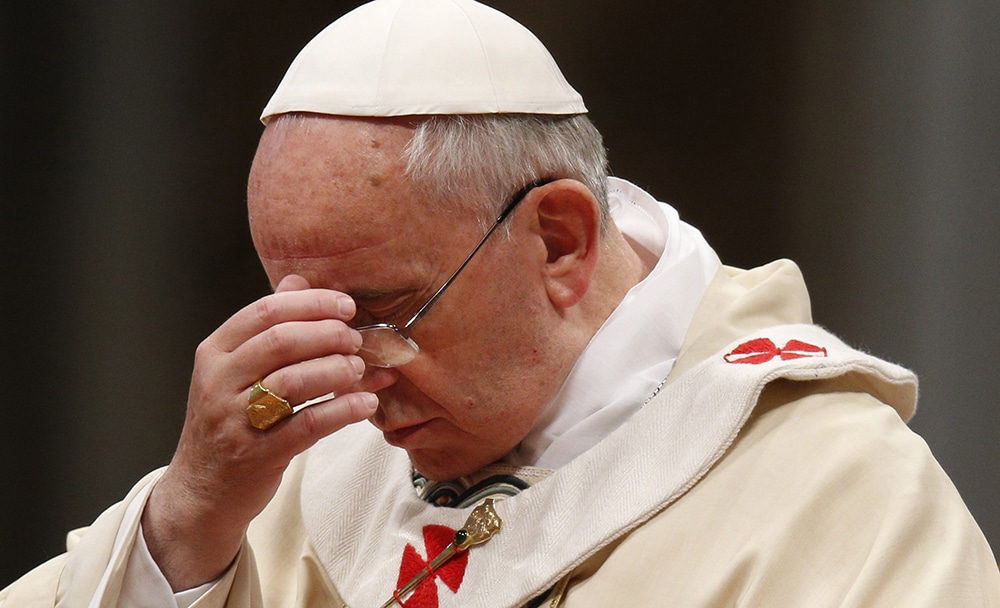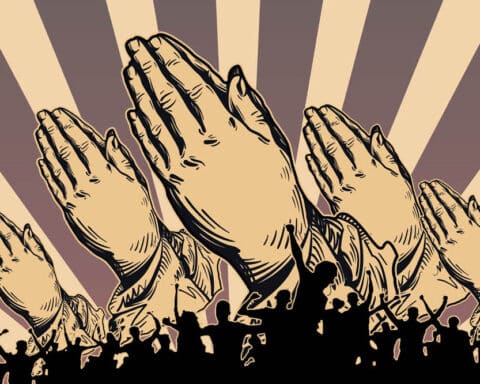I used to make the sign of the cross casually as a nice gesture for beginning and ending my prayers. But about a decade ago, probably nudged by the Holy Spirit, I took it more seriously.
I began to sign myself more frequently with faith and reverence. I did not think much about it, but after a year I noticed that I seemed to be doing measurably better in my Christian life. I was praying with more passion, resisting my bad inclinations somewhat more effectively, and relating to others more kindly.
When I asked myself what had produced these positive results, I decided the only thing I was doing differently was praying the Sign of the Cross more fervently. Pretty good, I thought, for just signing myself reverently, and I realized that the Sign of the Cross is not merely a pious gesture. It is a powerful prayer. So I studied about it in Scripture, the Church Fathers and saints, and Catholic teaching.
In my study, I discovered six perspectives on the Sign of the Cross that revealed why making it opens us to life-transforming graces. I share them here, confident that once you grasp them, you will make the gesture with more faith and experience its great blessings.
Mini-creed
The Sign of the Cross is a profession of faith in God as he revealed himself. It serves as an abbreviated form of the Apostles’ Creed. Touching our forehead, breast and shoulders, we declare our belief in the Father, Son and Holy Spirit. We are announcing our faith in what God has done — the creation of all things, the redemption of humanity from sin and death, and the establishment of the Church, which offers new life to all. When we sign ourselves we are making ourselves aware of God’s presence and opening ourselves to his action in our lives. That would be enough, wouldn’t it? But there is much, much more.
| Six Signings |
|---|
|
I invite you right now to imprint in your heart these six truths about the Sign of the Cross by making it with me six times, each time applying one of the perspectives.
First, let’s sign ourselves professing our faith in God.
Second, let’s mark our selves remembering that we died with Christ in baptism.
Third, let’s make the sign to declare that we belong to Christ and that we will obey him.
Fourth, let’s sign ourselves to embrace whatever suffering comes and to celebrate our suffering with Christ for the Church.
Fifth, let’s make the sign of the cross as a defense against the devil and as an offensive advance of God’s kingdom against him.
Sixth, let’s make it to crucify our flesh and to put on Christ and his behaviors.
I often go through these signings in my morning prayer and recommend that you try it, too.
|
Renewal of baptism
First-century Christians began making the sign of the cross as a reminder and renewal of what happened to them when they were baptized. It still works the same way for us. When we sign ourselves we are declaring that in baptism we died sacramentally with Christ on the cross and rose to a new life with him (see Rom 6:3-4 and Gal 2:20). We are asking the Lord to renew in us those baptismal graces. We are also acknowledging that baptism joined us to the body of Christ and equipped us for our role of collaborating with the Lord in his work of rescuing all people from sin and death.
Mark of discipleship
At baptism the Lord claimed us as his own by marking us with the Sign of the Cross. Now, when we sign ourselves, we are affirming our loyalty to him. By tracing the cross on our bodies, we are denying that we belong to ourselves and declaring that we belong to him alone (see Lk 9:23). The Church Fathers used the same word for the Sign of the Cross that the ancient world employed to indicate ownership. The same word named a shepherd’s brand on his sheep, a general’s tattoo on his soldiers, a householder’s mark on his servants, and the Lord’s mark on his disciples. So signing ourselves recognizes that we are Christ’s sheep and can count on his care; his soldiers, commissioned to work with him in advancing his kingdom on earth; and his servants, dedicated to doing whatever he tells us.
Acceptance of suffering
Jesus promised us, that suffering would be a normal part of a disciple’s life (see Lk 9:23). So, when we mark our bodies with the sign, we are embracing whatever pain comes as a consequence of our faith in Christ. Making the sign is our “taking up the cross and following” him (Lk 9:23). But at the same time it comforts us with the realization that Jesus, who endured the crucifixion for us, now joins us in our suffering and supports us. Signing ourselves also announces another significant truth: With St. Paul, we are celebrating that our afflictions as members of the body of Christ contribute to the Lord’s saving work of perfecting the Church in holiness (see Col 1:24).
Move against the devil
When the devil sent Jesus to the cross, he mistakenly believed he had won a great victory. Instead, the Lord surprised him with an ignominious defeat (see 1 Cor 2:8). From the first Easter morning through the present, the sign of the cross makes the devil cower and flee. So on one level, making the sign is a defensive move, declaring our inviolability to the devil’s influence. But more importantly, the sign is also an offensive weapon, helping us reclaim with Christ all that Satan lost at the cross. It announces our cooperation with him in the indomitable advance of the kingdom of God against the kingdom of darkness.
Victory over the flesh
In the New Testament, the word flesh sums up all the evil inclinations of our old nature that persist in us even after we die with Christ in baptism (see Gal 5:16-22). Making the sign of the cross expresses our decision to crucify these desires of the flesh and to live by the Spirit. Like tossing off a dirty shirt or blouse, making the sign indicates our stripping ourselves of our evil inclinations and clothing ourselves with the behaviors of Christ (see Col 3: 5-15).
The Church Fathers taught that the Sign of the Cross diffused the force of powerful temptations such as anger and lust.
So no matter how strongly we are tempted, we can use the Sign of the Cross to activate our freedom in Christ and conquer even our besetting sins.
Bert Ghezzi is the author of numerous books, including “The Sign of the Cross: Recovering the Power of the Ancient Prayer” (Loyola Press, $9.99).





